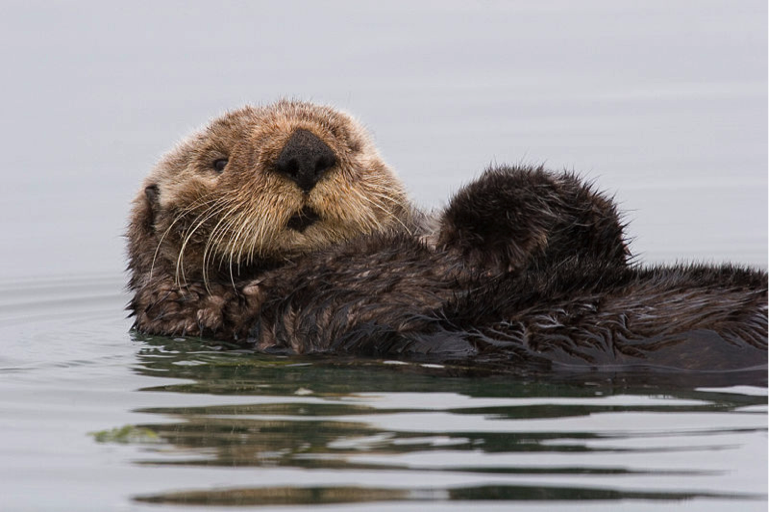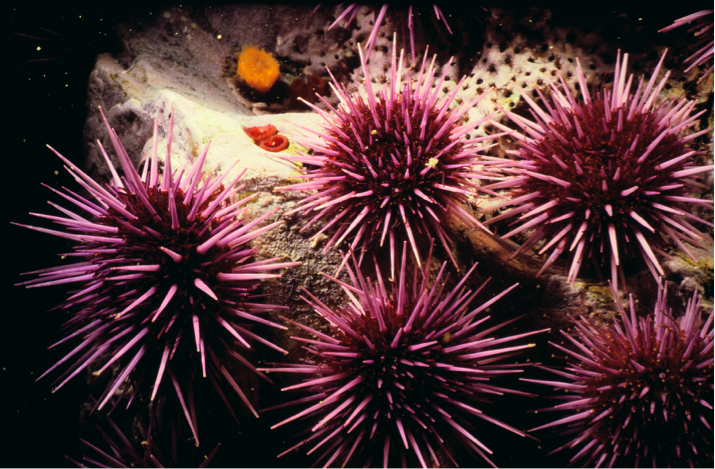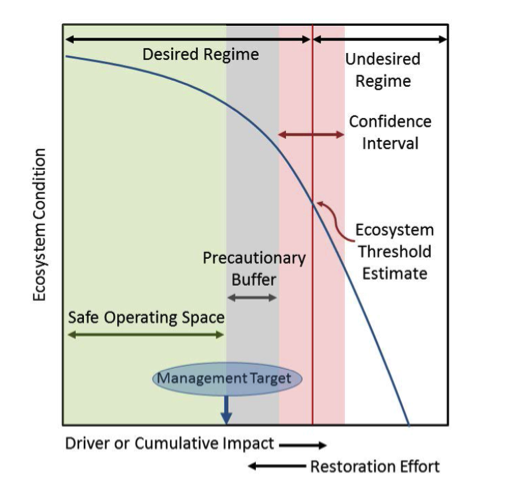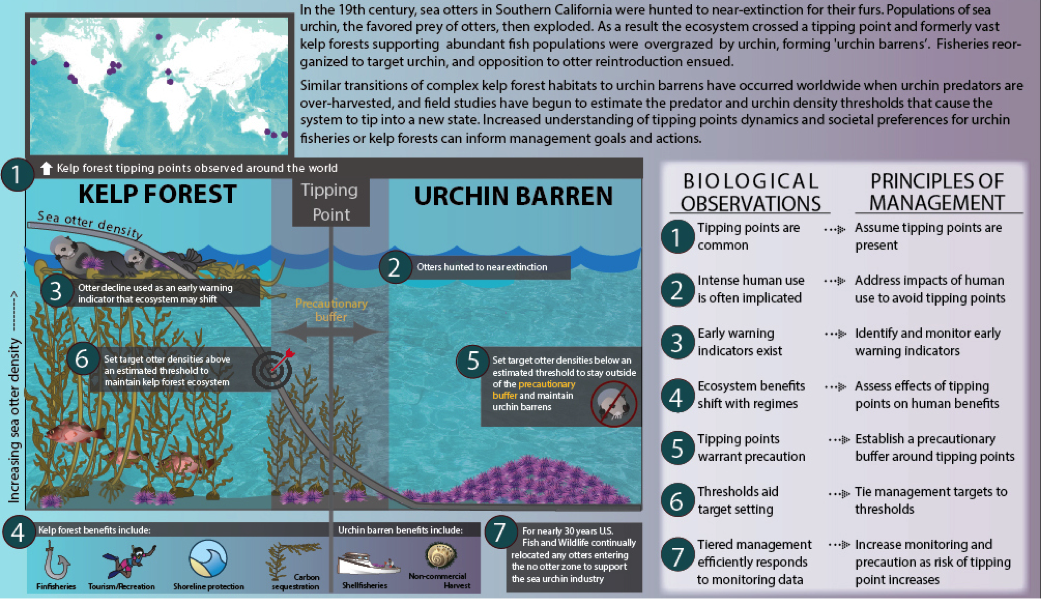
Check out the original blog post on OpenChannels at:
Part 4: Seven Principles for managing tipping points
Awareness is growing among scientists and environmental managers that human impacts can lead to dramatic, sometimes rapid, changes in the way that ecosystems look – for example, in the species and habitats that are dominant – andthe way they work – such as how productive they are, how rapidly nutrients are cycled, or what benefits they provide to people.
In our previous blog, we described how overfishing, effluent runoff, and other factors in Hawai‘i have pushed many coral reef-dominated ecosystems over a tipping point into algae-dominated ecosystems. While similar tipping point events have been documented in a variety of ecosystems, the challenge is predicting when such tipping points might occur in the face of limited information, and how to manage habitats to prevent these unwanted ecological shifts.
Recognizing a need for more explicit threshold-based management in marine ecosystems, Ocean Tipping Points project collaborators have outlined seven principles to help marine managers strategically predict and prevent tipping points when making resource management decisions in their jurisdictions. The principles are outlined in a new paper published this week in Ecosystem Health and Sustainability, entitled: ‘Principles for Managing Marine Ecosystems Prone to Tipping Points.’
The principles are based on observations that tipping points: (1) are common everywhere; (2) are associated with intense or multi-faceted human uses and impacts; (3) may be preceded by changes in early warning indicators; (4) may redistribute benefits among stakeholders; (5) may influence the relative costs of action and inaction; (6) can aid managers in selecting biologically-informed management targets; and (7) often require an adaptive, tiered response to environmental monitoring.
For each of the above observations, lead author Kim Selkoe (National Center for Ecological Analysis and Synthesis, Hawai`i Institute of Marine Biology) and her colleagues pair these principles with key considerations for resource management, and use examples from various ecosystems and management regimes across the globe to illustrate how the principles can be applied.

Sea otters act as keystone species in kelp forests, keeping urchin populations low enough to let kelp thrive.
From otters to urchins—linking tipping points to management targets
A classic example that illustrates how these seven tipping points principles manifest in practice is found in the kelp forest habitat off the western U.S. coast (see also Figure 1). As described in our first blog, the historic overhunting of sea otters caused localized extinctions throughout much of the species’ range, and had a huge impact on kelp forests. As a keystone species, otters maintain kelp habitat by eating sea urchins, the main consumers of kelp. In the absence of otters, urchin populations can grow unchecked, their out-of-control grazing undermining kelp forests and creating ‘urchin barrens’ devoid of the shelter and biodiversity that kelp ecosystems typically offer.

An overabundance of sea urchins can lead to ‘urchin barrens’ where kelp has been decimated.
The loss of sea otters marks a tipping point for kelp forest habitat. High urchin numbers cause a dramatic shift from a healthy kelp-dominated ecosystem to barren rock and sediment, along with an associated shift in number and type of species. Where kelp once harbored diverse assemblages of juvenile and adult fishes, invertebrates like urchins and shellfish now dominate the simplified habitat of an urchin barren.
In our new publication, we explain that when such tipping points occur, the distribution of ecosystem benefits to humans can shift considerably. For example, kelp habitats support important commercial fish species and attract diving and snorkeling tourism. However, in the absence of otters, urchin fishermen often gain substantial benefits and may be opposed to management interventions aimed at otter reestablishment. Thus, entrenchment in the present regime grows over time, as one group of human users continues to benefit from a system without otters.
Figure 1: Otters, Urchins, and Kelp—Oh My! This infographic depicts the seven principles of managing for tipping points applied to the kelp forest ecosystem.
As illustrated in Figure 1, this could mean that in some cases, urchin-dominated habitat becomes the desired regime (Figure 1, number 5) despite having lower biodiversity. In this case, keeping otter densities to a minimum would be the management goal. However, if kelp forest restoration were the goal, then increasing otter density to some minimum acceptable number (see Figure 2) would become the management target.
Tiered management: Reduce costs, reduce risk
Using a tiered management approach can help managers respond efficiently based on proximity to a tipping point. For example, when managers know their target ecosystem is at low risk of crossing a threshold, they may be able to adjust their monitoring accordingly. However, if risk increases due to frequency or intensity of human use or changes in non-anthropogenic environmental conditions, managers can intensify their monitoring efforts and take additional proactive management actions as appropriate; e.g., restricting harvest rates to protect vulnerable species.

Figure 2: Conceptual model for addressing tipping points using management targets. For example, if the desired regime is a healthy kelp forest ecosystem, the management target might focus on maintaining a critical number of otters. Assessments of cost, risk tolerance, and uncertainty around the threshold (confidence interval around ecosystem threshold estimate) guide the width of the precautionary buffer that puts management targets within the safe operating space. To maintain a desired regime, the management target would be a maximum limit of a driver or cumulative impact to avoid an undesirable tipping point. To restore a desired regime, the management target would be a minimum restoration effort required to cause a desirable tipping point response.
The effectiveness of such a tiered approach depends upon identifying early-warning indicators of pending change that are easily measurable. As long as such indicators exist, tiered management can help ecosystem managers set benchmarks, predict ecosystem shifts, perform cost-benefit analyses, and act in a timely fashion.
On the Ocean Tipping Points website, you can read about how Kruger National Park in South Africa implemented a successful tiered management strategy that incorporates both social and ecological objectives and monitors key indicators to predict possible tipping points. Their efforts have led to an increase in wildlife populations, particularly elephants. A similar approach could be applied to marine and coastal environments.
Applying principles of tipping points management
The principles outlined by the Ocean Tipping Points team highlight some of the top priorities for applied research, including: identifying early-warning indicators, estimating threshold levels of various impacts, and improving assessments of risk and societal preferences. Perhaps most importantly, the principles support the need for stakeholder engagement in target setting to determine how stakeholder benefits vary under different regimes; e.g., the switch from kelp forest to urchin barren, in which some fisheries benefits decline, while others increase.
While tipping points management ideally relies on strong data and good indicators, integrating these principles into current management practice can be a cost-effective, efficient, and practical approach for managing ecosystems prone to tipping points.
Photo Credit: Katie Davis, Mike Baird

